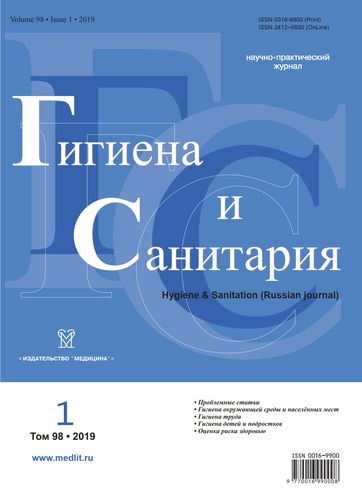Mycological damage of materials in the indoor environment as a risk factor for the health of polar explorers
- Authors: Vlasov D.Y.1,2, Teshebaev S.B.3, Zelenskaya M.S.1, Kirtsideli I.Y.2, Ryabusheva Y.V.1
-
Affiliations:
- Saint-Petersburg State University
- V.L. Komarov Botanical Institute of Russian Academy of Sciences
- Arctic and Antarctic Research Institute
- Issue: Vol 98, No 1 (2019)
- Pages: 17-21
- Section: ENVIRONMENTAL HYGIENE
- Published: 14.10.2020
- URL: https://ruspoj.com/0016-9900/article/view/640162
- DOI: https://doi.org/10.47470/0016-9900-2019-98-1-17-21
- ID: 640162
Cite item
Full Text
Abstract
The article presents the results of mycological analysis of samples taken from open surfaces in residential and working areas of the Arctic and Antarctic Research Institute (AARI) station on the Bolshevik island of the Northern Land archipelago. 114 samples were studied during the expedition work from 2014 to 2016. In total, 47 species of micromycetes were detected in the course of the research. Most of the species (89%) were identified as Ascomycetes. Mucor group of fungi was composed 11% out of all the identified species. The genus Penicillium was the richest in species diversity (16 species). On the surface of materials in places of the increased moisture, there was an open growth of colonies of the Penicillium species. P. expansum was the dominant one, being noted during all the years of observations with the occurrence of about 60%. Among the frequently occurring species, there were P. brevicompactum, P. herqueri, P. purpurogenum and P. waksmanii, which were also noted during all the years of observation (the total occurrence exceeded 15%, although in some years it was much higher). Dark-colored fungus Cladosporium cladosporioides was also dominated species, which in some cases formed black mold on the surface of the materials. Among the potential pathogens, 41 species were registered. A comparison of the data obtained over the years indicates in 2016 the largest number of microfungi to be detected in the indoor environment of AARI station (35 species), whereas in 2014 and 2015 only 29 species of fungi were identified. The similarity of the identified groups of fungi over the years turned out to be quite high. Approximately 36% of microfungi (17 species) were observed annually, although their occurrence over the years varied significantly. Locally accumulation of micromycetes was noted in the indoor environment: household rooms, storage places, workrooms. In these cases, the microfungi colonized the colorful coating, synthetic materials, plywood. The formation of mycobiota in the studied areas is due to anthropogenic invasion of microfungi.
About the authors
Dmitry Yu. Vlasov
Saint-Petersburg State University; V.L. Komarov Botanical Institute of Russian Academy of Sciences
Author for correspondence.
Email: dmitry.vlasov@mail.ru
ORCID iD: 0000-0002-0455-1462
MD, Ph.D., DSci., Professor of the Botany Department of the St. Petersburg State University, a leading researcher of the laboratory of the biochemistry of fungi of V.L. Komarov Botanical Institute of Russian Academy of Sciences,
St. Petersburg, 197376, Russian Federation.
e-mail: dmitry.vlasov@mail.ru
Russian FederationSh. B. Teshebaev
Arctic and Antarctic Research Institute
Email: noemail@neicon.ru
ORCID iD: 0000-0002-7530-0150
Russian Federation
M. S. Zelenskaya
Saint-Petersburg State University
Email: noemail@neicon.ru
ORCID iD: 0000-0003-3588-8583
Russian Federation
I. Yu. Kirtsideli
V.L. Komarov Botanical Institute of Russian Academy of Sciences
Email: noemail@neicon.ru
ORCID iD: 0000-0002-4736-2485
Russian Federation
Yu. V. Ryabusheva
Saint-Petersburg State University
Email: noemail@neicon.ru
ORCID iD: 0000-0001-6270-5207
Russian Federation
References
- Solonin YU.G., Bojko E.R. Medical and physiological aspects of life in the Arctic. Arktika: ehkologiya i ehkonomika. 2015; 1(17): 70–75. (In Russian).
- Ozerskaya S.M., Ivanushkina N.E., Kochkina G.A. Microfungi in connection with biological safety problems (review). Probemy medicinskoj mikologii. 2011; 13(3): 3–12. (In Russian).
- Vlasov D.Yu., Zelenskaya M.S., Kirtsideli I.YU., Abakumov E.V., Krylenkov V. A., Lukin V. V. Fungi on the natural and anthropogenic substrates in west Antarctica. Mikologiya i fitopatologiya. 2012; 46(1): 20–26. (In Russian).
- Ivanova A.M., Kirtsideli I.Yu. Microfungi complexes in Air of St.-Petersburg. Mikologiya i fitopatologiya. 2007; 41(1): 40-47. (In Russian).
- Antropova A.B., Bilanenko E.N., Mokeeva V.L., CHekunova L.N., Petrova-Nikitina A.D. Mycobiota in residential buildings of Moscow. Probemy medicinskoj mikologii. 2004; 6(2): 20–21. (In Russian).
- Shirokih A.A., Kolupaev A.V. Fungi in the biomonitoring of terrestrial ecosystems. Teoreticheskie problemy ehkologii. 2009; 3: 4–14. (In Russian).
- Kirtsideli I.Yu., Abakumov E.V., Teshebaev Sh.B., Zelenskaya M.S., Vlasov D.Yu., Krylenkov V.A., Ryabusheva Yu.V., Sokolov V.T., Barantsevich E.P. Microbial communites in regions of the arctic settelments. Gigiena i sanitariya. Moscow. 2016; 95(10): 923-929. (In Russian)
- Zelenskaya M.S., Kirtsideli I.Yu., Vlasov D.Yu., Krylenkov V.A., Sokolov V.T. Micromycetes - biodestructors in ecosystems of the Arctic. Problemy regional’noĭ ekologii. 2013; 5: 135–141. (In Russian).
- Kirtsideli I.Yu., Vlasov D.Yu., Abakumov E.V., Barantsevich E.P., Novozhilov Ju.K., Krylenkov V.A., Sokolov V.T. Airborne fungi in arctic settlement Tiksi (Russian Arctic, coast of the Laptev Sea). Czech Polar Reports. 2017; 7(2): 300–310.
- Kirtsideli I.Yu., Vlasov D.Yu., Krylenkov V.A., Sokolov V.T. Aeromikota in locations of the Russian Arctic stations in the water areas of the White, Barents and Kara Seas. Mikologiya i fitopatologiya. 2011; 45(3): 228–239. (In Russian).
- Sanitary rules SP 1.3.2322-08 “Security work with microorganisms of III - IV pathogenicity groups (hazard) and agents of parasitic infections”(In Russian).
- Satton D., Fotergill А., Rinaldi М. The determinant of pathogenic and opportunistic fungi. 2001, Мoscow, Мir, 469 p. (In Russian).
- Dorchakova E.V. Morphological and physiological features of toxin-forming fungi-biodestructors from the genus Stachybotrys (review). Probemy medicinskoj mikologii. 2011; 13 (3): 13–21. (In Russian).
- Marwah M.B. Evaluation of Silver Nanoparticles Toxicity against Toxic Black Mold Stachybotrys chartarum. J Plant Pathol Microbiol. 2017; 8:408. https://doi.org/10.4172/2157-7471.1000408
Supplementary files









